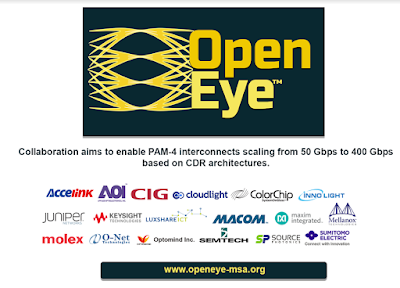The Open Eye Consortium has established a Multi-Source Agreement (MSA) aimed at standardizing advanced specifications for lower latency, more power efficient and lower cost 50 Gbps, 100 Gbps, 200 Gbps, and up to 400 Gbps optical modules for datacenter interconnects over single-mode and multimode fiber.
The MSA aims to accelerate the adoption of PAM-4 optical interconnects scaling to 50 Gbps, 100 Gbps, 200 Gbps, and 400 Gbps by expanding upon existing standards to enable optical module implementations using less complex, lower cost, lower power, and optimized clock and data recovery (CDR) based architectures in addition to existing digital signal processing (DSP) architectures. The idea is to minimize the use of digital signal processing in optical modules.
The Open Eye industry consortium said it is committed to developing an industry-standard optical interconnect that leverages seamless component interoperability among a broad group of industry-leading technology providers, including providers of electronics, lasers and optical components.
The initial Open Eye MSA specification will focus on 53 Gbps per lane PAM-4 solutions for 50G SFP, 100G DSFP, 100G SFP-DD, 200G QSFP, and 400G QSFP-DD and OSFP single-mode modules. Subsequent specifications will aim to address multimode and 100Gbps per lane applications. The initial specification release is planned for Fall 2019, with product availability to follow later in the year.
MACOM and Semtech Corporation initiated the formation of the Open Eye MSA with 19 current members in Promoter and Contributing membership classes.
Promoters include Applied Optoelectronics Inc., Cambridge Industries (CIG), Color Chip, Juniper Networks, Luxshare-ICT, MACOM, Mellanox, Molex and Semtech Corporation.
Contributors include: Accelink, Cloud Light Technology, InnoLight, Keysight Technologies, Maxim Integrated, O-Net, Optomind, Source Photonics and Sumitomo Electric.
“Through its participation in the Open Eye MSA, AOI is leveraging our laser and optical module technology to deliver benefits of low cost, high-speed connectivity to next generation data centers.” David (Chan Chih) Chen, AVP, Strategic Marketing for Transceiver, AOI
“MACOM continues to drive the industry’s technical requirements towards meeting the demands of Cloud Service Providers. Leveraging our proven leadership in 25G, 50G and 100G analog chipsets and optical components, we co-founded the Open Eye MSA to accelerate the adoption of 200G and 400G PAM optical interconnects. At the same time we are working in parallel to advance the DSP technologies necessary for faster connectivity speeds for future applications.” Preet Virk, Senior Vice President and General Manager, Networks, MACOM.
Companies interested in joining the Open Eye MSA can contact: admin@openeye-msa.org.
http://www.openeye-msa.org
The MSA aims to accelerate the adoption of PAM-4 optical interconnects scaling to 50 Gbps, 100 Gbps, 200 Gbps, and 400 Gbps by expanding upon existing standards to enable optical module implementations using less complex, lower cost, lower power, and optimized clock and data recovery (CDR) based architectures in addition to existing digital signal processing (DSP) architectures. The idea is to minimize the use of digital signal processing in optical modules.
The Open Eye industry consortium said it is committed to developing an industry-standard optical interconnect that leverages seamless component interoperability among a broad group of industry-leading technology providers, including providers of electronics, lasers and optical components.
The initial Open Eye MSA specification will focus on 53 Gbps per lane PAM-4 solutions for 50G SFP, 100G DSFP, 100G SFP-DD, 200G QSFP, and 400G QSFP-DD and OSFP single-mode modules. Subsequent specifications will aim to address multimode and 100Gbps per lane applications. The initial specification release is planned for Fall 2019, with product availability to follow later in the year.
MACOM and Semtech Corporation initiated the formation of the Open Eye MSA with 19 current members in Promoter and Contributing membership classes.
Promoters include Applied Optoelectronics Inc., Cambridge Industries (CIG), Color Chip, Juniper Networks, Luxshare-ICT, MACOM, Mellanox, Molex and Semtech Corporation.
Contributors include: Accelink, Cloud Light Technology, InnoLight, Keysight Technologies, Maxim Integrated, O-Net, Optomind, Source Photonics and Sumitomo Electric.
“Through its participation in the Open Eye MSA, AOI is leveraging our laser and optical module technology to deliver benefits of low cost, high-speed connectivity to next generation data centers.” David (Chan Chih) Chen, AVP, Strategic Marketing for Transceiver, AOI
“MACOM continues to drive the industry’s technical requirements towards meeting the demands of Cloud Service Providers. Leveraging our proven leadership in 25G, 50G and 100G analog chipsets and optical components, we co-founded the Open Eye MSA to accelerate the adoption of 200G and 400G PAM optical interconnects. At the same time we are working in parallel to advance the DSP technologies necessary for faster connectivity speeds for future applications.” Preet Virk, Senior Vice President and General Manager, Networks, MACOM.
Companies interested in joining the Open Eye MSA can contact: admin@openeye-msa.org.
http://www.openeye-msa.org























